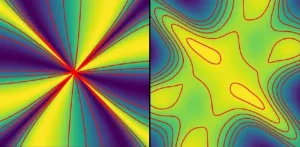(Press-News.org) Excitations in solids can also be represented mathematically as quasiparticles; for example, lattice vibrations that increase with temperature can be well described as phonons. Mathematically, also quasiparticles can be described that have never been observed in a material before. If such "theoretical" quasiparticles have interesting talents, then it is worth taking a closer look. Take fractons, for example.
Perfect storage of information
Fractons are fractions of spin excitations and are not allowed to possess kinetic energy. As a consequence, they are completely stationary and immobile. This makes fractons new candidates for perfectly secure information storage. Especially since they can be moved under special conditions, namely piggyback on another quasiparticle. "Fractons have emerged from a mathematical extension of quantum electrodynamics, in which electric fields are treated not as vectors but as tensors - completely detached from real materials," explains Prof. Dr. Johannes Reuther, theoretical physicist at the Freie Universität Berlin and at HZB.
Simple models
In order to be able to observe fractons experimentally in the future, it is necessary to find model systems that are as simple as possible: Therefore, octahedral crystal structures with antiferromagnetically interacting corner atoms were modelled first. This revealed special patterns with characteristic pinch points in the spin correlations, which in principle can also be detected experimentally in a real material with neutron experiments. "In previous work, however, the spins were treated like classical vectors, without taking quantum fluctuations into account," says Reuther.
Including quantum fluctuations
This is why Reuther, together with Yasir Iqbal from the Indian Institute of Technology in Chennai, India, and his doctoral student Nils Niggemann, has now included quantum fluctuations in the calculation of this octahedral solid-state system for the first time. These are very complex numerical calculations, that in principle are able to map fractons. "The result surprised us, because we actually see that quantum fluctuations do not enhance the visibility of fractons, but on the contrary, completely blur them, even at absolute zero temperature," says Niggemann.
In the next step, the three theoretical physicists want to develop a model in which quantum fluctuations can be regulated up or down. A kind of intermediate world between classical solid-state physics and the previous simulations, in which the extended quantum electrodynamic theory with its fractons can be studied in more detail.
From theory to experiment
No material is yet known to exhibit fractons. But if the next model gives more precise indications of what the crystal structure and magnetic interactions should be like, then experimental physicists could start designing and measuring such materials. "I do not see an application of these findings in the next few years, but perhaps in the coming decades and then it would be the famous quantum leap, with really new properties," says Reuther.
Text: A. Rötger
END
Fractons as information storage: Not yet quite tangible, but close
Fractons are perfectly immobile, thus candidates for data storage. But yet, no real material is known, in which fractons show up. A team has now modelled these quasiparticles more closely and unveiled an unexpected behavior.
2023-05-26
ELSE PRESS RELEASES FROM THIS DATE:
Defence lawyers face challenges accessing and reviewing digital evidence, study shows
2023-05-26
Defence lawyers face numerous challenges accessing and reviewing evidence from phones and computers, a new study shows.
Solicitors and barristers have reported their use of digital evidence can be restricted by limited or late access, large volumes of material, and tight turnaround times to secure legal aid funding and choose and instruct independent experts.
The research calls for more clarity and transparency around the collection and analysis of digital evidence and the streamlining of the format and presentation of information.
The current volume and diversity of digital evidence available escalates tensions, delays access to digital ...
Barren habitat for sows leaves imprint on piglets’ brains
2023-05-26
In a new study, researchers from Uppsala University in Sweden, together with colleagues from the University of São Paulo, Brazil, have investigated the impact that a barren living environment for sows leaves on the next generation. The pigs in the study were bred in Brazil and kept according to breeding standards in that country. The sows’ uncomfortable and unstimulating environment brought with it several different types of changes in the epigenome of their offspring.
In many parts of the world, sows are kept confined in concrete stalls while they are pregnant. This is a bad environment for the pigs, both in terms ...
Quantum sensor for a future navigation system tested aboard Royal Navy ship
2023-05-26
A prototype quantum sensor with potential applications in GPS-free navigation, developed at Imperial College London, has been tested in collaboration with the Royal Navy.
The test marks an important step in bringing new quantum technologies out of the lab and into real-world settings.
Many navigation systems today rely on global navigation satellite systems (GNSS), such as GPS, which uses signals from satellites orbiting the Earth. However, GPS navigation is not always accessible, obstacles like tall buildings can easily block the satellite signals, and they are also susceptible ...
Hydrogen sulfide in cancer treatment
2023-05-26
Hydrogen sulfide is usually a highly toxic gas. However, with careful preparation, it can be used to support photothermal therapy (PTT) in treating cancer, as a team of researchers reporting in the journal Angewandte Chemie has recently discovered. As the team reports, an adjuvant releasing hydrogen sulfide causes tumor cells to lose their natural heat protection and thus to become significantly more sensitive to PTT.
Breathing in gaseous hydrogen sulfide usually causes us to suffocate, because the gas suppresses the respiratory chain in the mitochondria, ...
First death in the UK associated with Xylazine
2023-05-26
The death of a 43-year-old male is the first in the UK to be associated with Xylazine and marks the entry of the drug into the UK drug supply.
New research published in the Journal of Forensic and Legal Medicine from King’s College London details the death of the man in May 2022 from the effects of Xylazine alongside heroin, fentanyl and cocaine.
Xylazine is a non-opioid sedative, painkiller and muscle relaxant used in veterinary medicine as a tranquiliser for large animals. The drug – known ...
Developing a blueprint for mobile data visualisation
2023-05-26
By Jovina Ang
SMU Office of Research – It is predicted that by 2025, almost three quarters of the internet users in the world will be mobile-only users.
While mobile devices provide ready access to data, there are limitations to how the data can be optimally presented due to the small form factor and limited screen size.
For example, it is a lot easier to show 10,000 data points on a desktop compared to a smartphone, which typically has a screen size of 2.82 inches (71.5 mm) ...
Optimising outcomes for older adults
2023-05-26
By Alistair Jones
SMU Office of Research – The contribution of team members on a research project can get taken for granted, with storied senior leaders gaining most of the attention.
A recent exception is Micah Tan, an associate researcher at the Centre for Research on Successful Ageing (ROSA) at Singapore Management University (SMU). For his collaborative work at ROSA, Tan was recognised with an inaugural 2022 Research Staff Excellence Award.
“Winning the award has given me a strong sense of fulfilment and has inspired me to want to do more, both for the SMU community but also more generally in terms of ...
Harnessing large vision-language models
2023-05-26
By Alistair Jones
SMU Office of Research – The terminology of artificial intelligence (AI) and its many acronyms can be confusing for a lay person, particularly as AI develops in sophistication.
Among the developments is deep learning – a machine learning technique that teaches computers to learn by example.
“Deep learning has brought many major changes to AI, especially in natural language processing (NLP) and computer vision, two sub areas of AI,” says Jing Jiang, a Professor of Computer Science at Singapore Management University (SMU).
“In my field, which is NLP, the solution ...
State policies can boost use of anti-opioid medication
2023-05-26
States that want to increase access to buprenorphine, a lifesaving medication used to treat opioid use disorder, should consider efforts to enhance professional education and clinician knowledge, according to a new RAND Corporation study.
Examining six state-level policies aimed at boosting use of buprenorphine, researchers found that requiring buprenorphine prescribers to receive additional education beyond the initially required instruction, as well as continuing medical education related to substance misuse, were both associated with a significant increase in use of the treatment.
The findings are published in the latest edition of the journal JAMA Health Forum.
“Many ...
Association of healthy lifestyle factors and obesity-related diseases in adults in the UK
2023-05-26
About The Study: In this study of 438,000 UK Biobank participants, adherence to a healthy lifestyle was associated with reduced risk of a wide range of obesity-related diseases, but this association was modest in adults with obesity. The findings suggest that although a healthy lifestyle seems to be beneficial, it does not entirely offset the health risks associated with obesity.
Authors: Sebastien Czernichow, M.D., Ph.D., of the Hopital Europeen Georges Pompidou in Paris, is the corresponding author.
To access the embargoed study: Visit our For The Media website at this link https://media.jamanetwork.com/
(doi:10.1001/jamanetworkopen.2023.14741)
Editor’s ...
LAST 30 PRESS RELEASES:
School meals could unlock major gains for human and planetary health
Menopause hormone therapy does not appear to impact dementia risk
Signature patterns of brain activity may help predict recovery from traumatic brain injury
Dresden study uncovers new key mechanism in cancer cells
New species are now being discovered faster than ever before, study suggests
Cannabis-based products show limited short-term benefit for chronic pain, with increased risk of adverse effects
Cannabis products with more THC slightly reduce pain but cause more side effects
Clearing the brain of aging cells could aid epilepsy and reduce seizures
Brain injuries linked with potential risk of suicide, new study finds
New technique lights up where drugs go in the body, cell by cell
New study finds movement of fishing fleets can reveal shifts in marine ecosystems
Embargoed: New evidence points to potential treatment for vascular dementia
Study uncovers disrupted brain balance in alcohol dependence
Working in groups can help Republicans and Democrats agree on controversial content moderation online
Structural findings reveal how distinct GPCR ligands create different levels of activation
Anything-goes “anyons” may be at the root of surprising quantum experiments
UC review: Maximizing workplace opportunity for veterans
From generation to complex control: Metasurfaces make perfect vortex beams "within reach"
Thin-film lithium niobate-based detector: recent advances and perspectives
Exploring why some people may tend to persistently make bad choices
How cells balance their protein levels
Nirsevimab vs RSVpreF vaccine for RSV–related hospitalization in newborns
Effectiveness and impact of maternal RSV immunization and nirsevimab on medically attended RSV in US children
AI gives scientists a boost, but at the cost of too many mediocre papers
Next-generation vision model maps tree growth at sub-meter precision
Genes aren’t destiny for inherited blindness, study shows
MIT study: High-fat diets make liver cells more likely to become cancerous
Exposure to multiple fine particulate matter components and incident depression in the US Medicare population
Risk of burdensome health care spending over time in the US
Nirsevimab against hospitalizations and emergency department visits for lower respiratory tract infection in infants
[Press-News.org] Fractons as information storage: Not yet quite tangible, but closeFractons are perfectly immobile, thus candidates for data storage. But yet, no real material is known, in which fractons show up. A team has now modelled these quasiparticles more closely and unveiled an unexpected behavior.




